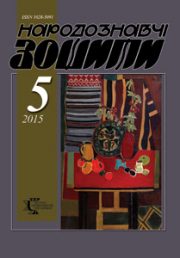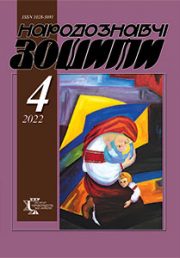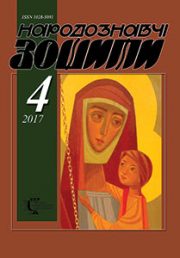The Ethnology Notebooks. 2019, № 6 (150), 1598—1605
UDK75.071.1-055.1(092):75.046.5(477)”17″
DOI https://doi.org/10.15407/nz2019.06.1598
CULTURAL TRANSFER THEORY AND ART STUDIES: APPLICATION TO ARTIST’S BIOGRAPHY CASE STUDY
LEVYTSKA Mariana
ORCID ID: https://orcid.org/0000-0002-0977-4470
PhD (candidate in Art Studies), Associate Professor,
Research Associate of the Department of Art Studies
The Ethnology Institute
National Academy of Sciences of Ukraine
15, Svobody ave, 79000, Lviv, Ukraine
e-mail: m.levytska@gmail.com
Abstract. Introduction. The article considers the key positions of the cultural transfer’s theory and their potential for the studies of Ukrainian fine art. Whereas the contextual art history is focused on the cultural milieu, artistic contacts and connections, then the theory of cultural transfer can be applied for the interpretation of artefacts have been created as a result of cultural interaction. Problem statement. This theoretical model is suitable for the re-invention of the well-known Ukrainian art phenomena, for instance, a late Baroque religious painting of the Uniate tradition. Purpose. Based on the example of the creative biography of Luka Dolynskyy, a significant Ukrainian painter of the 18th c., the application of the specified methodology aims to give the interpretation of the artist’s artworks a broader Central European art context. «Creative biography» as a definition implies the artist’s activity, analyzed in the context of his displacements in space and cultural transitions during his life.
Methods. Using a cultural transfer method in art history, research is based on publications of L. Musner (2005), W. Moser (2011), W. Schmale (2012), M. Dmitrieva (2015). It should also be highlighted that the «geography of art» approach has been put forward by T. Da Costa Kaufmann (2004) and P. Piotrowski (2009) has developed it concerning Central European art history. However, J. Biaіostocki (1979) was their predecessor in certain aspects. In particular, he has argumented the active participation of the art periphery in the selection or rejection of some artistic models.
Results. In this special Dolynsky’s case changes of his artistic manner and technique after studies in Vienna can be clearly observed. Thereby, Dolynsky’s creative aspirations in his first major project in St. George cathedral in Lviv are directly related to the circle of his Viennese teachers as C.F. Sambach and Austrian monumentalists as D. Gran, F.A. Maulberch, M. Kremzer-Schmidt. Thus, from a local little-known artist, Dolynsky moves into a much wider cultural area, in which not only the Austrian but also the Italian school of the 18th century can be traced. Conclusions. As a conclusion has been proved that current theoretical progress in the cultural transfer methodology has opened up new opportunities for the creative biography analyses and made it possible to evaluate local artistic phenomena on a wider comparative background.
Keywords: cultural transfer, horizontal art history, creative biography, religious painting, Uniate Church.
Received 19.10.2019
REFERENCES
D’Alleva, A. (2006). How to Write Art History. Laurence King Publishing.
Doliсski, Lukasz, & Derwojed, J. (1975). Dictionary of the Polish Atrists and Foreign Artists, who lived in Poland: in 5 v. (Vol. 2, pp. 78—79). Warsaw [in Polish].
Skochylias, I. (2010). Halych (L’viv) Eparchy of the 12—18th centuries: organizational structure and the legal status. Lviv [in Ukrainian].
Los, V., Wodzianowska, I., & Laszkiewicz, H. (Ed.). (2012). Basilian Libraries in the Light of the Monasteries’ Inventories (Right-Bank Ukraine 18—19th cc.) in Vernadskyy National Library of Ukraine. In Between Rome and Novosibirsk. Anniversary book dedicated to p. M. Radvan SCJ (Pp. 612—620). Lublin [in Ukrainian].
Stetsiuk, Y. (2005). Basilian Monasteries of the Peremyshl Eparchy: Institutional Development, Economic Situation and Religious Activity (the end of 17th—18th centuries) (PhD Thesis). Lviv [in Ukrainian].
Yakovenko, N. (2007). Introduction to History. Kyiv: Krytyka [in Ukrainian].
Bobryk, W., & Gil, A. (2010). On the Border of the Worlds. Essays about the Orthodox and Uniate Churches in Eastern Europe in the Middle Ages and the Modern Period. Lublin; Siedlce.
Ovsiychuk, V. (2001). Classicism and Romantcism in Ukrainian Art. Kyiv [in Ukrainian].
Hordynskyy, S. (1973). Ukrainian Icon of the 12—18th centuries. Philadelphia: Providence [in Ukrainian].
Neumann, B., & Nьnning, A. (Eds.). (2012). Travelling Concepts for the Study of Culture (Ansgar). Berlin and Boston: de Gruyter.
Musner, L., & Mitterbauer, H. (Eds.). (2005). Kulturals Transfer: Ein regulationstheoretischer Zugang am Beispiel der Architektur. In Ent-grenzte Raume: Kulturelle Transfers um 1900 und in der Gegenwart, Vienna [in German].
Da Costa Kaufmann, T. (2004). Toward a Geography of Art. Chicago et al.
Hock, B. & Allas, A. (2018). Globalizing East European art Histories: Past and Present. Routledge.
Moser, W. Cultural Transfer and its Complexities. A Case Study on Transnational and Transhistorical Mobilities of the Baroque. Retrieved from: https://www.unil.ch/lleuc/files/live/sites/lleuc/files/shared/Cultural_transfer_DK.pdf
Murawska-Muthesius, K. (2013). Mapping Eastern Europe: Cartography and Art History. In Artl@s Bulletin-2, 2 (Article 3, pp. 15—25).
Writing Central European Art History: Patterns. Travelling Lecture Set 2008/2009. Vienna: Erste Foundation, 4.
Dmitrieva, E. (2011). Theory of Cultural Transfer and Comparative Methods in Humanities: Opposition or Succession? Issues of Literature, 4, 302—313 [in Russian].
Dmitrieva, M. (2015). Italy in the Sarmatia. Pathways of the Renaissance in the Eastern Europe. Moskva: NLO [in Russian].
Cultural Transfer, by Wolfgang Schmale (Original in German, translated in English, published 2012-05-12). Retrieved from: http://ieg-ego.eu/en/threads/theories-and-methods/cultural-transfer (Last accessed: 11-09-2018).
Biaіostocki, J. (1976). The Art of the Renaissance in Eastern Europe: Hungary — Bohemia — Poland. London.
Schmale, W. (2012). Das 18 Jahrhundert. Vienna [in German].
Schmale, W. (Ed.) (2003). Kulturtransfer: Kulturelle Praxis im 16 Jahrhundert (Pp. 41—62). Innsbruck [in German].
East-Central European Art Forum. International conference «Theorizing the Geography of East-Central European Art». Retrieved from: http://arthist.amu.edu.pl/konferencjatheorizing-the-geography-of-east-central-european-art/ (Last accessed: 14-09-2018).
Piotrowski, P. Toward a Horizontal History of the European Avant-Garde (P. 59—60). Retrieved from: https://monoskop.org/images/9/93/Piotrowski_Piotr_2009_Toward_a_Horizontal_History_of_the_European_Avant-Garde.pdf (Last accessed: 27-08-2018).
Rampley, M., & Lenain, T. (Eds.). (2012). Art History and Visual Studies in Europe. Transnational discourses and National Frameworks. Brill: Leiden; Boston.
Onians, John. (Ed.). Atlas of World Art (2004). Laurence King Publishing.
Burke, P. (Ed.) (2007). Cultural Translation in Early Modern Europe (Pp. 125—141). Cambridge.
Calabi, D. (Ed.). (2007). Cities and Cultural Exchange in Europe: 1400—1700 (Pp. 286—314). Cambridge.
Da Costa Kaufmann, T. (2005). Painterly Enlightenment: The Art of Franz Anton Maulbertsch, 1724—1796. University of North Carolina Press.
Ludera, M. (2016). Gabriel Sіawinski. Late Baroque Painter in the Service of the Roman and Greek-Catholic Church. Krakow [in Polish].
Holubets, M. (1924). Dolynskyy. Lviv [in Ukrainian].
Fenczak, A. (1995). Latinisation or Oxidentalisation? About the New Approaches towards the Western Influence on Identity of the Greek-Catholic Church in Poland between 1596—1772. Informational Bulletin of the South-East Scientific Institute in Przemysl, 1, 46—48 [in Polish].
Krasny, P. (2003). Church Architecture on the Ruthenian Lands of the Commonwelth. 1596—1914. Krakow: Universitas [in Polish].
Middell, M., & Langer. A. (Ed.). (2001). Von der Wechselseitigkeit der Kulturen im Austausch. Das Konzept des Kulturtransfers in verschiedenen Forschungskontexten. Metropolen und Kulturtransfer im 15/16. Jahrhundert. Prag; Krakau; Danzig; Wien; Stuttgart: Steiner. P. 15—51.
Harries, K. (1983). The Bavarian Rococo Church: Between Faith and Aesteticism. Yale University Press, New Haven and London.
Levytska, M. (2011). The Viennese Experience of Luka Dolynskyy (1775—1777). In Notes of NTS. Works of the Fine and Decorative Art Comission (Vol. CCLXI, pp. 223—232). Lviv [in Ukrainian].
Levytska, M. (2016). Representation of the Apostles and Prophets in the Luka Dolynskyy’ Iconostasis Cycles (of the End of 18th — beginning of 19th centuries): in the Search of Intentions. In Christian Sacral Tradition: Faith, Spirituality, Art. Pro Khrystyanska sakralna tradytsiya: vira, dukhovnist, mystetstvo. Proceedings of the International scientific conference (Pp. 255—271). Lviv: LPBA UPC KP [in Ukrainian].
Arijcuk, P., Hindelang, E., & Slavicek, L. (Eds.). (2007). Franz Anton Maulbertsch oder Caspar Frаnz Sambach. In: Franz Anton Maulbertsch und Mitteleuropa (Pp. 244—246). Museum Langenargen am Bodensee — Seminar of the Art History MU. Brno [in Cheh.).
Garzarolli-Thurnlackh, K. [B. r.]. Die Barocke Handzeichnung in Osterreich, 27—28; 67; 82—85; 97—98. Zurich; Wien; Leipzig: Amalthea Verlag [in German].







